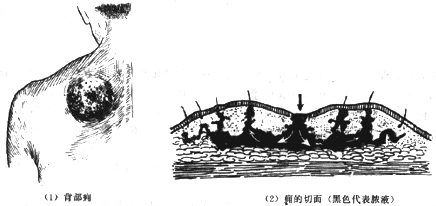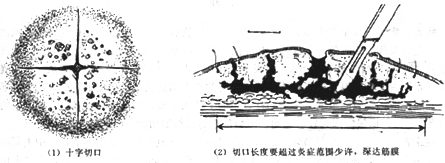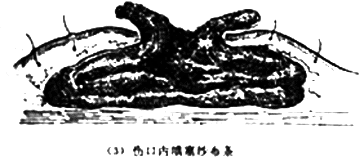| disease | Carbuncle |
| alias | Carbuncle, Aphtha |
A carbuncle is an acute suppurative infection of multiple adjacent hair follicles and their associated sebaceous or sweat glands, or formed by the fusion of multiple boils. The causative agent is Staphylococcus aureus. In Chinese medicine, it is referred to as "ju." A carbuncle on the neck is commonly known as "dui aphtha," and it typically begins at the base of the back.
bubble_chart Pathological Changes
Due to the thickness of the skin, the infection can only spread through the subcutaneous fat columns with weaker resistance to the subcutaneous tissue, diffusing along the deep fascia membrane in all directions, invading many nearby fat tissues, and then ascending to the hair follicle groups to form a carbuncle with multiple "pus heads" (Figure 2). Diabetic patients are more prone to carbuncles because their white blood cell function is poor and their movement is sluggish.

Figure 2 Carbuncle
bubble_chart Clinical Manifestations
The carbuncle presents as a slightly raised, purplish-red infiltrated area with a tough texture and indistinct borders. The central surface has multiple pustular plugs, which, upon rupture, form a honeycomb-like appearance. Subsequently, the central area gradually undergoes necrosis, dissolution, and collapse, resembling a "volcanic crater," containing pus and a large amount of necrotic tissue. The carbuncle tends to spread to the surrounding areas and deeper tissues, with surrounding infiltrative edema, and local lymph nodes may become swollen and painful. In addition to severe local pain, patients often exhibit significant systemic symptoms such as fear of cold, fever, poor appetite, and increased white blood cell count. Carbuncles not only have more severe local lesions than boils but are also prone to complicating systemic purulent infections. Lip carbuncles are particularly dangerous as they can easily lead to intracranial cavernous sinusitis.
bubble_chart Treatment Measures
1. Systemic Treatment: The patient should rest appropriately and strengthen nutrition. Analgesics may be used when necessary. Antibacterial drugs such as sulfamethoxazole plus trimethoprim, penicillin, or erythromycin can be selected. If diabetes is present, insulin and dietary control should be administered according to the condition.
2. Local Treatment: Initial Stage [First Stage] - Redness and Swelling Stage: Treatment is the same as for a boil. For those already ulcerated, Eight-To-Two Powder can be applied to the wound, followed by Taiyi Plaster. If the area of redness and swelling is large, there is a lot of necrotic tissue in the center, or systemic symptoms are severe, surgical treatment should be performed, but it is not suitable for lip carbuncles. Generally, a "+" or "++" shaped incision is used, and sometimes a "|||" shaped incision can also be made. The length of the incision should slightly exceed the inflammatory area, reaching the fascia, and all necrotic tissue should be removed as much as possible. The wound is packed with gauze or iodoform gauze to stop bleeding (Figure 1). Subsequently, the dressing is changed daily, ensuring that the gauze strips are inserted into every corner of the wound, lifting the edge of the skin flap to facilitate drainage. Granulation-Promoting Powder can be used inside the wound to promote the growth of granulation tissue. If the wound surface is too large, skin grafting can be considered once the granulation tissue is healthy. Direct carbuncle excision can also be performed, followed by skin grafting once the granulation tissue grows, which can shorten the treatment course.


Figure 1: Incision and Drainage of Carbuncle.
Pay attention to personal hygiene, keep the skin clean, and treat boils promptly to prevent the spread of infection.




